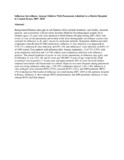| dc.contributor.author | Bulimo, W.D | |
| dc.contributor.author | Onyango, Clayton O. | |
| dc.contributor.author | Njeru, Regina | |
| dc.contributor.author | Kazungu, Sidi | |
| dc.contributor.author | Achilla, Rachel | |
| dc.contributor.author | Welch, Stephen R | |
| dc.contributor.author | Cane, Patricia | |
| dc.date.accessioned | 2013-05-30T12:03:19Z | |
| dc.date.available | 2013-05-30T12:03:19Z | |
| dc.date.issued | 2012 | |
| dc.identifier.citation | Influenza Surveillance Among Children With Pneumonia Admitted to a District Hospital in Coastal Kenya, 2007–2010, Onyango, Clayton O., Njeru Regina, Kazungu Sidi, Achilla Rachel, Bulimo Wallace, Welch Stephen R., Cane Patricia A., Gunson Rory N., Hammitt Laura L., Scott Anthony J. G., Berkley James A., and Nokes James D. , Journal of Infectious Diseases, December 15, 201, Volume 206, Number suppl 1, p.S61-S67, (2012) | en |
| dc.identifier.uri | http://profiles.uonbi.ac.ke/wallacebulimo/publications/influenza-surveillance-among-children-pneumonia-admitted-district-hospi-0 | |
| dc.identifier.uri | http://erepository.uonbi.ac.ke:8080/xmlui/handle/123456789/27658 | |
| dc.description.abstract | Background.Influenza data gaps in sub-Saharan Africa include incidence, case fatality, seasonal patterns, and associations with prevalent disorders.Methods.Nasopharyngeal samples from children aged <12 years who were admitted to Kilifi District Hospital during 2007–2010 with severe or very severe pneumonia and resided in the local demographic surveillance system were screened for influenza A, B, and C viruses by molecular methods. Outpatient children provided comparative data.Results.Of 2002 admissions, influenza A virus infection was diagnosed in 3.5% (71), influenza B virus infection, in 0.9% (19); and influenza C virus infection, in 0.8% (11 of 1404 tested). Four patients with influenza died. Among outpatients, 13 of 331 (3.9%) with acute respiratory infection and 1 of 196 without acute respiratory infection were influenza positive. The annual incidence of severe or very severe pneumonia, of influenza (any type), and of influenza A, was 1321, 60, and 43 cases per 100 000 <5 years of age, respectively. Peak occurrence was in quarters 3–4 each year, and approximately 50% of cases involved infants: temporal association with bacteremia was absent. Hypoxia was more frequent among pneumonia cases involving influenza (odds ratio, 1.78; 95% confidence interval, 1.04–1.96). Influenza A virus subtypes were seasonal H3N2 (57%), seasonal H1N1 (12%), and 2009 pandemic H1N1 (7%).Conclusions.The burden of influenza was small during 2007–2010 in this pediatric hospital in Kenya. Influenza A virus subtype H3N2 predominated, and 2009 pandemic influenza A virus subtype H1N1 had little impact | en |
| dc.language.iso | en | en |
| dc.publisher | University of Nairobi. | en |
| dc.title | Influenza Surveillance Among Children With Pneumonia Admitted to a District Hospital in Coastal Kenya, 2007–2010 | en |
| dc.type | Article | en |
| local.publisher | College of Health Sciences, University of Nairobi, Kenya | en |

